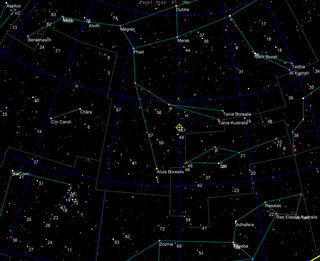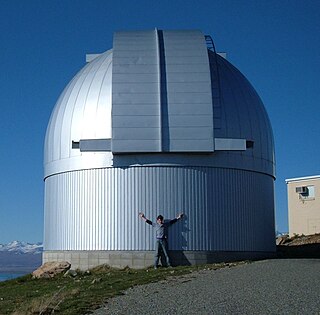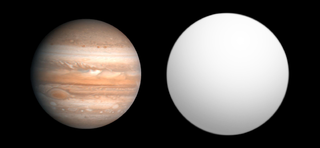Related Research Articles

47 Ursae Majoris, formally named Chalawan, is a yellow dwarf star approximately 45.3 light-years from Earth in the constellation of Ursa Major. As of 2011, three extrasolar planets are believed to orbit the star.
HD 37124 is a star in the equatorial constellation of Taurus, positioned about a half degree to the SSW of the bright star Zeta Tauri. The apparent visual magnitude of this star is 7.68, which is too dim to be visible to the naked eye. It is located at a distance of 103 light years from the Sun based on parallax, but is drifting closer with a radial velocity of −23 km/s. Three extrasolar planets have been found to orbit the star.

Gliese 876 is a red dwarf star 15.2 light-years away from Earth in the constellation of Aquarius. It is one of the closest known stars to the Sun confirmed to possess a planetary system with more than two planets, after GJ 1061, YZ Ceti, Tau Ceti, and Wolf 1061; as of 2018, four extrasolar planets have been found to orbit the star. The planetary system is also notable for the orbital properties of its planets. It is the only known system of orbital companions to exhibit a near-triple conjunction in the rare phenomenon of Laplace resonance. It is also the first extrasolar system around a normal star with measured coplanarity. While planets b and c are located in the system's habitable zone, they are giant planets believed to be analogous to Jupiter.
HD 169830 is a star in the southern constellation of Sagittarius. It has a yellow-white hue and is dimly visible to the naked eye with an apparent visual magnitude of +5.90. The star is located at a distance of 120 light years from the Sun based on parallax. It is drifting closer with a radial velocity of −17.3 km/s, and is predicted to come as close as 20.7 ly (6.4 pc) in 2.08 million years. HD 169830 is known to be orbited by two large Jupiter-like exoplanets.

54 Piscium is an orange dwarf star approximately 36 light-years away in the constellation of Pisces. In 2003, an extrasolar planet was confirmed to be orbiting the star, and in 2006, a brown dwarf was also discovered orbiting it.
OGLE-TR-111 is a yellow dwarf star approximately 5,000 light-years away in the constellation of Carina. Having an apparent magnitude of about 17, this distant and dim star has not yet been cataloged. Because its apparent brightness changes when one of its planets transits, the star has been given the variable star designation V759 Carinae.
OGLE-TR-132 is a distant magnitude 15.72 star in the star fields of the constellation Carina. Because of its great distance, about 4,900 light-years, and location in the crowded field it was not notable in any way. Because its apparent brightness changes when one of its planets transits, the star has been given the variable star designation V742 Carinae. The spectral type of the star is type F. A yellow-white, very metal-rich dwarf star, it is slightly hotter and more luminous than the Sun.

OGLE-TR-10b is an extrasolar planet orbiting the star OGLE-TR-10.

Gravitational microlensing is an astronomical phenomenon due to the gravitational lens effect. It can be used to detect objects that range from the mass of a planet to the mass of a star, regardless of the light they emit. Typically, astronomers can only detect bright objects that emit much light (stars) or large objects that block background light. These objects make up only a minor portion of the mass of a galaxy. Microlensing allows the study of objects that emit little or no light.

The Optical Gravitational Lensing Experiment (OGLE) is a Polish astronomical project based at the University of Warsaw that runs a long-term variability sky survey (1992–present). The main goals are the detection and classification of variable stars, discovery of microlensing events, dwarf novae, and studies of the structure of the Galaxy and the Magellanic Clouds. Since the project began in 1992, it has discovered a multitude of extrasolar planets, together with the first planet discovered using the transit method (OGLE-TR-56b) and gravitational microlensing. The project has been led by professor Andrzej Udalski since its inception.

Microlensing Observations in Astrophysics (MOA) is a collaborative project between researchers in New Zealand and Japan, led by Professor Yasushi Muraki of Nagoya University. They use microlensing to observe dark matter, extra-solar planets, and stellar atmospheres from the Southern Hemisphere. The group concentrates especially on the detection and observation of gravitational microlensing events of high magnification, of order 100 or more, as these provide the greatest sensitivity to extrasolar planets. They work with other groups in Australia, the United States and elsewhere. Observations are conducted at New Zealand's Mt. John University Observatory using a 1.8 m (70.9 in) reflector telescope built for the project.
OGLE-TR-56 is a dim, distant, magnitude 17 Sun-like star located approximately 1,500 parsecs away in the constellation of Sagittarius. This star is listed as an eclipsing type variable star with the eclipse due to the passage of the planet as noted in the discovery papers.

OGLE-TR-56b is an extrasolar planet located approximately 1500 parsecs or 5000 light years away in the constellation of Sagittarius, orbiting the star OGLE-TR-56. This planet was the first known exoplanet to be discovered with the transit method. The object was discovered by the OGLE project, announced on July 5, 2002 and confirmed on January 4, 2003 by the Doppler technique. The period of this confirmed planet was the shortest until the confirmed discovery of WASP-12b on April 1, 2008. The short period and proximity of the OGLE-TR-56 b to its host mean it belongs to a class of objects known as hot Jupiters.
OGLE-2003-BLG-235L (MOA-2003-BLG-53L) is a star in the constellation of Sagittarius. The first gravitational microlensing event for which a planet orbiting the lens was detected around this star. The event occurred in during July 2003. Two groups observed and independently detected the event: the Optical Gravitational Lensing Experiment (OGLE) and the Microlensing Observations in Astrophysics (MOA), hence, the double designation. It is an orange dwarf star of spectral type K, which is accompanied by a giant planet.
OGLE-2005-BLG-169L is a dim and distant magnitude 20 galactic bulge star located about 2,700 parsecs away in the constellation Sagittarius. If it is a main sequence star, then it is most likely a red dwarf with about half of the mass of the Sun. Other possibilities are a white dwarf star, or a neutron star or black hole.
OGLE-2005-BLG-169Lb is an extrasolar planet located approximately 2,700 parsecs away in the constellation of Sagittarius, orbiting the star OGLE-2005-BLG-169L. This planet was discovered by the OGLE project using the gravitational microlensing method. Based on a most likely mass for the host star of 0.49 solar mass (M☉), the planet has a mass of 13 times that of Earth (MEarth). Its mass and estimated temperature are close to those of Uranus. It is speculated that this planet may either be an ice giant like Uranus, or a "naked super-Earth" with a solid icy or rocky surface.
OGLE-2005-BLG-071L is a distant, magnitude 19.5 galactic bulge star located in the constellation Scorpius, approximately 11,000 light years away from the Solar System. The star is probably a red dwarf with a mass 43% of that of the Sun.

OGLE-TR-113b is an extrasolar planet orbiting the star OGLE-TR-113.

OGLE-TR-111b is an extrasolar planet approximately 5,000 light-years away in the constellation of Carina. The planet is currently the only confirmed planet orbiting the star OGLE-TR-111.
References
- ↑ Bond, I. A.; et al. (2004). "OGLE 2003-BLG-235/MOA 2003-BLG-53: A Planetary Microlensing Event". The Astrophysical Journal Letters. 606 (2): L155–L158. arXiv: astro-ph/0404309 . Bibcode:2004ApJ...606L.155B. doi:10.1086/420928. S2CID 17610640.
- ↑ Bennett, David P.; et al. (2006). "Identification of the OGLE-2003-BLG-235/MOA-2003-BLG-53 Planetary Host Star". The Astrophysical Journal Letters. 647 (2): L171–L174. arXiv: astro-ph/0606038 . Bibcode:2006ApJ...647L.171B. doi:10.1086/507585. S2CID 11294425.